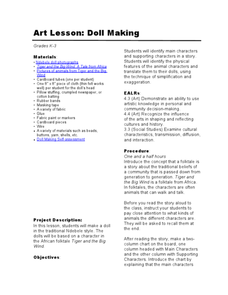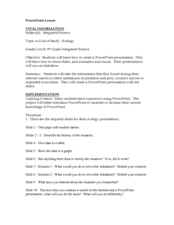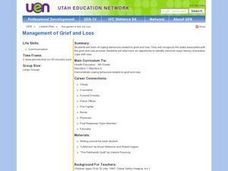Novelinks
Agree or Disagree: Dr. Jekyll and Mr. Hyde
Good or evil? That is the question embedded in an anticipation guide designed for those who are about to read Robert Louis Stevenson's The Strange Case of Dr. Jekyll and Mr. Hyde.
PB Works
The Cay by Theodore Taylor
Record the plot elements of The Cay on this activity. Pupils note basic information about the book and answer questions about the introduction, point of view, character, conflict, rising action, climax, falling action, and resolution of...
Curated OER
The Keeping Quilt
Students discover story analysis by discussing a book the class reads together. In this reading comprehension lesson, students read the book The Keeping Quilt and discuss the different characters and plot points among the class. ...
Curated OER
Dear Character
Third graders examine and better explain a character and their traits by writing a letter from their point of view.
Curated OER
Science: The Big Sleep and Criminalistics
Students view the film, "The Big Sleep" focusing on the investigation techniques employed by the main character. Throughout the viewing, students respond to essay questions explaining actions by the characters. The questions center on...
Curated OER
"Theseus and the Minotaur"
Learners analyze the features of myths and legends. They read the myths "Theseus and the Minotaur" and "Orpheus and Eurydice," identify the myth story elements, evaluate each story for the overall theme, describe the characters, and...
Curated OER
Computer Mysteries
Who has been messing with my trampoline? Young writers choose local events as the basis for their own “Who Did It?” mystery. They then devise a plot, problem, and cast of characters and write an introduction explaining the problem and...
Curated OER
Phenomenology Lesson Plan #4: Character Part 1
Young scholars examine the way they react to characters and text. They write respones to different media tests. They are required to bring in a photograph and create a mini-biography for homework.
Curated OER
Literary Analysis of Theme
Remember reading "The Lottery" and "The Possibility of Evil" by Shirley Jackson? Learners can experience and analyze the tension, themes, and human experience found in these pieces through reading and class discussion. They use...
Manchester College
What’s Your Point of View?
Work on deciphering the point of view of various pieces of literature. As readers review the concepts of first, second, and third person perspective, they apply what they know to different passages.
Curated OER
Doll Making
Learners discuss folktales and read Tiger and The Big Wind, listening for animal characters for later discussion. In this language arts lesson, students complete a T chart on characters and make a doll for one either chosen or assigned....
Orange County Department of Education
The Lost and Found
Third graders explain the definition of integrity and respect and provide examples from the story The Lost and Found's characters and their own lives that illustrate both. They describe in their journals why and how they think Wendell...
Curated OER
Loving Literature
First graders, after having "Are You My Mother?" by P.D. Eastman read to them, participate in group discussions or independentally work to analyze a spreadsheet to identify essential elements in the story and graph their data. In...
Curated OER
Ecology
Students personify ecology vocabulary and write a one-act play using their knowledge of ecology as the basis for characters, conflict, setting and plot.
Curated OER
Race, Culture, And Identity in Daughter From Danang (Part 1)
Students examine cultural identity. They watch the PBS documentary, 'Daughter From Danang,' answer discussion questions, and write an essay regarding the characters ethnicities and stereotypes portrayed in the film.
Curated OER
The Rain Cycle
Third graders draw the rain cycle. In this rain cycle lesson the students listen to the story The Legend of the Bluebonnet by Tommie DePola. As they listen to the story they sketch what is happening. The students write a sentence for...
Curated OER
Comic Book or Comic Strip Design
Students design an original cartoon character. They explain the creative process and development of a cartoon from brainstorming to final draft and study different types of cartooning. Use the correct terminology associated with cartooning
Curated OER
Reading Response Questions
In this reading response worksheet, students answer twenty three questions in short answer format. They answer questions on their reading relating to basic facts, making predictions, explaining why or how, making connections, and giving...
Curated OER
What is Opera? Fill in the Blank
In this opera worksheet, students fill in 17 blanks in an essay that explains the composition of an opera. They use the words given in two word banks which include recitative, chorus, solo, ensemble, scenes, aria, and duet.
Curated OER
Hooway for Wodney Wat
Students examine speech difficulties by reading a children's book in class. In this children's literature lesson, students read the story Hooway for Wodney the Wat, and analyze the characters, story and the bullying that takes place....
Curated OER
Designing a Robot and Microsoft PowerPoints
Ninth graders discover the uses and main characteristics of robots then design a robot that performs a task that people do not want to do. Colored drawings of their robot are created including labels of the parts and explanations of...
Curated OER
Characterization
Students read the book Sylvester and the Magic Pebble. In this character traits activity, students read the book and identify character traits. Students draw pictures of a character from the book and describe the character traits.
Curated OER
Enrichment Activities - "Mrs. Frisby and the Rats of NIMH"
Fifth graders read the novel "Mrs. Frisby and the Rats of NIMH." They discuss the various characters in the book, and the different types of conflict that take place within the book. They also research owls and rats to make comparisons...
Curated OER
Management of Grief and Loss
Fifth graders learn of coping behaviors related to grief and loss. They recognize the tasks associated with the grief and loss process. They also have an opportunity to identify common ways literary characters cope with loss.

























